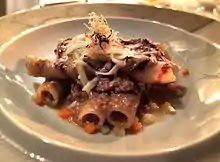Genovese sauce
Genovese sauce is a rich, onion-based pasta sauce from the region of Campania, Italy. Likely introduced to Naples from the northern Italian city of Genoa during the Renaissance, it has since become famous in Campania and forgotten elsewhere.
 Genovese sauce with candele pasta served at the Villa Cimbrone in Ravello, Campania, Italy | |
| Type | Sauce |
|---|---|
| Place of origin | Italy |
| Region or state | Campania |
| Created by | Genovese immigrants |
| Invented | 15th or 16th centuries |
| Main ingredients | Onion |
| Ingredients generally used | Beef, veal or pork |
The sauce is unusual for the long preparation time used to soften and flavor the onions.
History
Despite its name, which means "in the style of Genoa," Genovese sauce is a principal pasta sauce of Naples and an important part of its culinary history, having been introduced to the city in the 15th or 16th centuries.[1][2] The sauce may have been brought by Genovese immigrants or merchants, at a time when Genoa and Naples were two of Italy's most important ports.[1][3] It could also be referring to its inventor's name, since Genovese is a widespread surname in Campania. Genovese sauce is now unknown beyond Campania.[4]
The sauce's use of onions may reflect a French influence, and resembles Boeuf à la mode.[1] During the mid 19th century, ‘Salmon in Hollandaise and Genovese sauce’ was served in the Grand Véfour restaurant of the Palais-Royal in Paris as a luxury dish.[5]
Genovese sauce is not to be confused with Pesto from Genoa and Liguria, nor with Salsa Genovese, a red wine and vegetable condiment for fish,[6] nor with the sauce génevoise from Lake Geneva, again served with fish.
Preparation
Genovese sauce is prepared by sautéing either beef or veal in a large number of onions, for at least two but as many as ten hours.[1][3][7] The onions are typically accompanied by minced carrots and celery in what is known as a soffritto.[1][2][3][7][8]
The slow cooking of the onions is especially important for the sauce's flavor,[9] and is facilitated by incremental additions of white wine, stock, or both.[1][3] The sauce and accompanying pasta can be served with the meat from the sauce or separately, garnished with tomatoes, and topped with pecorino.[2][7]
Large, cylindrical pasta like rigatoni, ziti or candele are favored because they can hold the rich sauce.[1][2]
Ingredients for 4 plates
Meat 600 g, golden onions 1 kg, carrots 60 g, celery 60 g, olive oil.
See also
References
- Seed, Diane (2012). The Top One Hundred Pasta Sauces. Random House. pp. 137–8.
- May, Tony (2005). Italian Cuisine: The New Essential Reference to the Riches of the Italian Table. Macmillan. pp. 31–32.
- Licino, Hal. "The Greatest Pasta Sauce You've Never Tasted". Hubpages. Retrieved 23 July 2013.
- Asimov, Eric (28 August 2002). "Restaurants: the cooking of Naples, pure and simple". The New York Times.
- Kingston, Ralph (2012). Bureaucrats and Bourgeois Society: Office Politics and Individual Credit in France 1789-1848. Palgrave Macmillan. p. 141.
- Plotkin, Fred (1997). Recipes from Paradise: Life & Food on the Italian Riviera. Little, Brown and Company. p. 86. ISBN 0316710717.
- Alberts, Bonnie. "Cooking with Giuseppe – Paccheri alla Genovese". Retrieved 23 July 2013.
- Schwartz, Arthur (1998). Naples at Table: Cooking in Campania. HarperCollins. p. 4.
- Rosentals, John (31 May 1990). "THE Sheraton Hobart has added more variety to the theme nights it has been running in the hotel's Gazebo Restaurant". Hobart Mercury.